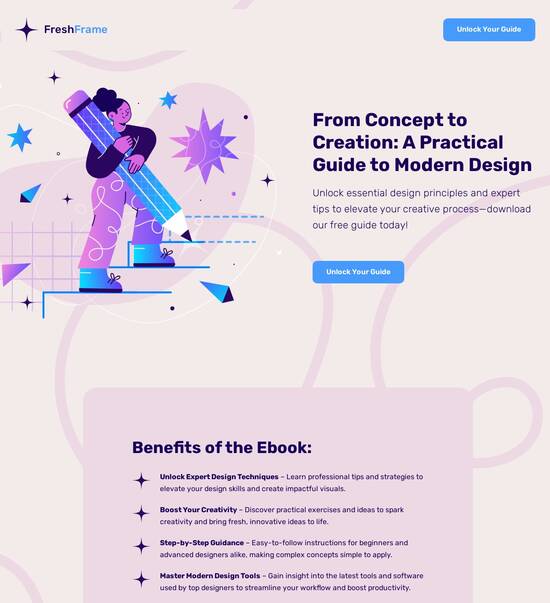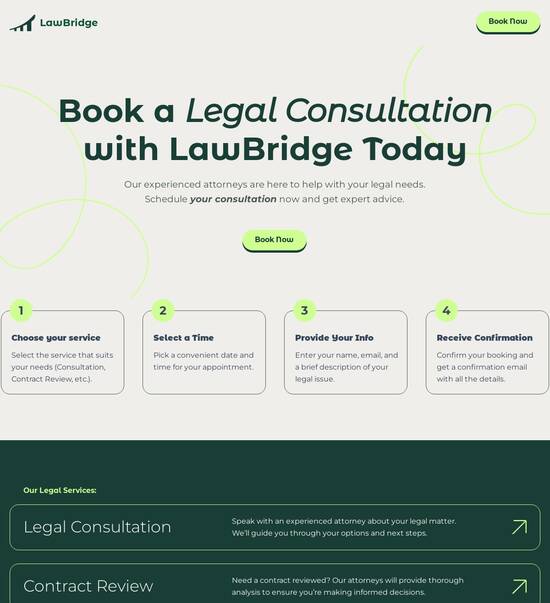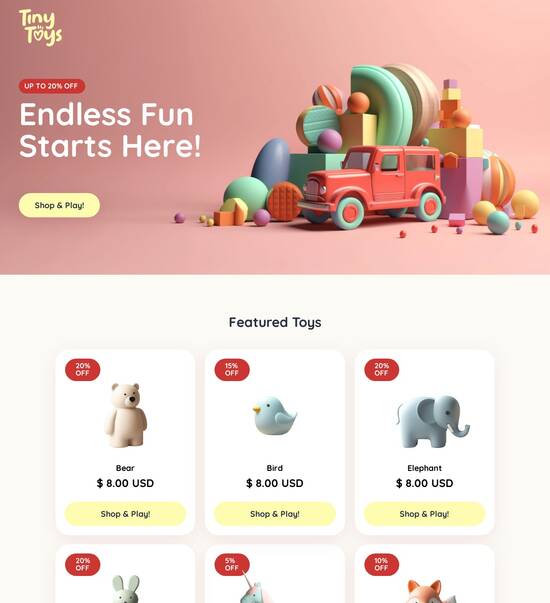
HTML page template for Strategic Planning professionals
Use TemplateAbout template
Showcase your expertise using Instapage’s personalized landing page templates for Strategic Planning professionals. Time to attract those clients!
Recommended templates

Easy to build without coding
With the intuitive drag-and-drop builder, anyone on your team can create high-converting pages without any knowledge of code or design. Make enhancements to your landing page with custom widgets using Javascript, HTML/CSS, or third-party scripts.

Multiple layouts for any industry and goal
Select from 500+ landing page layouts built to boost conversions across industry-specific scenarios. Customize them by adjusting fonts, adding images, and generating on-brand content with the AI assistant. Quickly scale with Instablocks® and Global Blocks that you can save, reuse, and update globally.

Loads fast and looks polished on any device
Every template is responsive, which means they present professionally on any device and load blazingly fast with our Thor Render Engine. You can also power them up with Google AMP technology to deliver an unparalleled mobile experience and drive higher conversions.

Robust analytics & experimentation
Get real-time updates and reporting across all your devices, showing the number of visitors, conversions, cost-per-visitor, and cost-per-lead. Launch AI-powered experiments, run A/B tests, and use heatmaps to analyze user behavior, then optimize your landing page to maximize conversions.







Easy to build without coding
With the intuitive drag-and-drop builder, anyone on your team can create high-converting pages without any knowledge of code or design. Make enhancements to your landing page with custom widgets using Javascript, HTML/CSS, or third-party scripts.
Multiple layouts for any industry and goal
Select from 500+ landing page layouts built to boost conversions across industry-specific scenarios. Customize them by adjusting fonts, adding images, and generating on-brand content with the AI assistant. Quickly scale with Instablocks® and Global Blocks that you can save, reuse, and update globally.
Loads fast and looks polished on any device
Every template is responsive, which means they present professionally on any device and load blazingly fast with our Thor Render Engine.
Robust analytics & experimentation
Get real-time updates and reporting across all your devices, showing the number of visitors, conversions, cost-per-visitor, and cost-per-lead. Launch AI-powered experiments, run A/B tests, and use heatmaps to analyze user behavior, then optimize your landing page to maximize conversions.
All the features you need to build strategy on a page template
Explore more featuresLearn how to build strategic planning page template
FAQs
Leading the way in building high-performing landing pages





Maximize your marketing ROI with instapage: a step-by-step guide
If you’re looking to enhance the performance of your marketing campaigns, utilizing Instapage as your landing page and Conversion Rate Optimization (CRO) platform is the answer. This all-in-one tool enables marketers to create high-converting pages that drive results swiftly and effectively. Here, we explore a step-by-step approach to making the most out of Instapage for your digital marketing needs.
Understanding instapage: a powerful landing page tool
Instapage stands out with its user-friendly interface and extensive features tailored for diverse industries such as business services, tech, and education. The platform offers 100+ high-converting templates that save valuable time and effort. Additionally, using pre-built lead generation elements allows for immediate engagement, crucial in maximizing your marketing ROI.
- High-converting templates: These templates are designed to capture attention and convert visitors into leads.
- Pre-built lead generation elements: Simplifying the collection of visitor information to drive future marketing efforts.
- Ease of use: No coding required, enabling marketers of all skill levels to create effective campaigns.
Step 1: Creating your landing page
Begin by selecting a template that aligns with your campaign goals. Instapage’s library of conversion-focused layouts and Instablocks makes it quick to customize without needing any developer assistance.
Step 2: Optimize for conversions
Now that your landing page is built, it's time to use Instapage's built-in experimentation features to optimize performance.
- Implement A/B testing: Compare versions of your landing page to identify what resonates best with your audience.
- Use heatmaps: Analyze user behavior on your page to improve placement of key elements.
- Track performance: Utilize the analytics dashboard to monitor engagement and conversion rates.
Step 3: Personalize your campaigns
To drive even better performance, leverage personalization tools available on Instapage.
- Dynamic text replacement: Display personalized messaging that engages visitors based on their search queries.
- AdMaps: Align specific ads with unique landing pages to ensure a cohesive experience.
- Behavioral data tracking: Gather insights at the audience level to refine your messaging further.
By following these steps, you’ll create landing pages that not only attract visitors but convert them effectively, benefiting your overall marketing strategy.
Ready to transform your marketing campaigns? Start using Instapage today to leverage its powerful features for better engagement and higher ROI!
People also ask about HTML page template for Strategic Planning professionals
Navigating the Landscape of HTML Page Templates for Strategic Planning Professionals
The importance of custom HTML page templates in strategic planning
In the world of strategic planning, the ability to present ideas clearly and effectively is paramount. Custom HTML page templates serve as vital tools that can help professionals articulate their plans while maintaining a cohesive structure. These templates not only streamline the planning process but also facilitate better understanding among teams.
Defining strategic planning needs becomes easier with the help of templates. By standardizing processes, these templates ensure that every stakeholder is on the same page, literally and figuratively. Moreover, they enhance collaboration among professionals. As teams utilize the same structure, sharing insights and providing feedback becomes more efficient.
Rapid development and iteration of planning documents
Consistency in branding and messaging across materials
Improved clarity and engagement through designer-driven layouts
Essential features of HTML page templates
When it comes to designing HTML templates for strategic planning, several essential features must be included to maximize effectiveness. Tag management plays a crucial role in both SEO and analytics optimization. HTML tags not only help in organizing content but also in making it more digestible for search engines.
Using HTML tags efficiently can improve page rankings, making it easier for stakeholders to find strategic documents. Furthermore, dynamic functionality and interactivity are key features that encourage engagement from stakeholders. Elements such as feedback forms, quizzes, or even calculators can be embedded into the templates, providing a more interactive experience.
SEO-optimized tags for better visibility
Interactive elements to capture stakeholder input
User-friendly navigation to enhance accessibility
Navigating the technical aspects
Successful deployment of HTML page templates for strategic planning professionals requires careful consideration of technical aspects, such as browser compatibility and usability. Ensuring that templates are functional across different web browsers is vital. This minimizes potential access issues, enabling stakeholders to focus on the content rather than struggling with presentation problems.
Testing and optimizing templates for various platforms is essential. Conducting cross-browser testing can reveal inconsistencies, allowing for timely adjustments to improve user experience. Another important factor is handling lazy loading, a technique designed to improve performance, which is advantageous for busy strategists working with large files.
Use browser testing software for compatibility checks
Implement lazy loading for images and content to boost performance
Focus on mobile responsiveness to reach stakeholder audiences effectively
Visual design elements that resonate
The visual design of HTML templates has a significant impact on the effectiveness of strategic planning documents. Choosing the right colors is essential, as different shades evoke various emotions and can influence decision-making. Tools like Adobe Color and Coolors can assist in selecting palettes that align with the strategic objectives.
Furthermore, typography plays a critical role in readability and engagement. Choosing the appropriate fonts ensures that information is not just accessible, but also appealing to the reader. Best practices include using a maximum of two to three fonts and maintaining consistency throughout the document.
Select colors based on psychological impact theories
Utilize web-safe fonts for universal readability
Incorporate white space for a clean and navigable layout
Structuring your page layout effectively
A well-structured layout is crucial for the clarity and effectiveness of HTML templates. The design of headers and footers contributes to consistent navigation and branding. Including elements like a logo, contact information, and essential links can simplify user interactions and provide a clear pathway for stakeholders to follow.
Maximizing columns for information distribution also enhances readability. Multi-column layouts allow for organized presentation of diverse data sets, which is particularly useful for strategic planning documents that require analysis of complex information.
Incorporate navigational elements in headers and footers
Utilize multi-column formats to streamline information
Enhance clarity with bullet points and numbered lists for key insights
Subtle but powerful design elements
Innovative use of layouts can transform how information is conveyed. Exploring grid systems versus free-form layouts offers strategic planners the flexibility to choose an arrangement that best showcases their data. Case studies have demonstrated how effective layout designs enhance comprehension and retention.
Incorporating engaging content types, such as infographics, videos, or interactive tools, can further enrich the user experience. Striking a balance between textual content and visual elements ensures that both types of information are adequately represented, guiding stakeholders toward informed decisions.
Experiment with grid layouts for a structured look
Use interactive content to present data compellingly
Ensure clarity by combining text with visuals effectively
Multimedia integration for enhanced engagement
Incorporating multimedia elements like videos and interactive media can significantly enrich HTML templates for strategic planning. Video content has been shown to engage viewers more effectively than text alone. Best practices for embedding videos include ensuring compatibility with multiple devices and optimizing for quick loading times.
Optimizing images is also crucial to enhance user engagement. Techniques such as compression and responsive image design are necessary to ensure images load quickly without sacrificing quality. This step is especially important when dealing with large visual files, which can hinder user experience if not handled properly.
Embed videos using responsive frameworks to guarantee versatility
Implement image optimization techniques for faster load times
Incorporate alternative text for all multimedia to enhance SEO
Content management and organization
Efficiently managing content within HTML templates involves understanding the nuances of DOMContentLoaded events. This term relates to when the browser has fully loaded HTML, which is essential for executing JavaScript that enhances interactivity. Recognizing this aspect can help strategists better manage their template execution and improve overall performance.
Additionally, strategic planning professionals often encounter common problems such as slow load times and unresponsive designs. Addressing these issues can significantly enhance user satisfaction and retention. Employing best practices like deferred loading for scripts and utilizing lightweight CSS frameworks can help alleviate many performance-related challenges.
Understand how DOM events affect template loading and interactivity
Utilize deferred loading to enhance page speed
Stay informed on troubleshooting common HTML template issues
Streamlined collaboration via the download panel
The download panel feature within HTML page templates greatly enhances collaboration among strategic planning professionals. This functionality streamlines the process of exporting and sharing templates, making it easier for teams to collaborate efficiently. By integrating tools that allow instant downloads, users can ensure that everyone is working from the same version of a document.
Moreover, sharing templates within teams can foster a more collaborative environment. Stakeholders can work on documents simultaneously, providing real-time feedback and edits. Therefore, having a user-friendly download panel can significantly boost productivity in strategic planning initiatives.
Facilitate easy template sharing through integrated download features
Encourage real-time edits to refine planning documents
Foster collaboration with external stakeholders through shared panels
Exploring the HTML builder functionality
As strategic planning professionals look to personalize their templates, user-friendly HTML builders are increasingly popular. These tools feature drag-and-drop functionality, empowering users to create customized templates without needing extensive coding knowledge. By democratizing the design process, teams can focus on content rather than grappling with technical challenges.
Future trends in HTML builders are expected to further adapt to user needs, incorporating features such as AI-driven suggestions for layouts or content. Keeping abreast of these trends enables strategic planning professionals to leverage new technologies effectively and remain competitive.
Utilize drag-and-drop interfaces for easier template customization
Explore AI-driven features for enhanced design suggestions
Remain adaptable to new technologies and best practices in template design
Case studies: Successful implementation of HTML templates
Highlighting real-world examples of HTML templates in action showcases their effectiveness in transforming strategic planning processes. Professionals from diverse industries have leveraged templates to streamline workflows and enhance collaboration. For instance, companies that integrated HTML templates into their planning practices showed significant efficiency improvements in document creation and stakeholder engagement.
Key takeaways from these success stories illustrate best practices for others to adopt. By utilizing templates that prioritize user experience and foster clear communication, strategic planners can achieve their goals more effectively. Furthermore, understanding the nuances of template design can help organizations tailor their approaches to meet specific needs.
Analyze case studies to identify effective template strategies
Adopt best practices learned from successful implementations
Customize designs based on organizational requirements and stakeholders
Envisioning the future of strategic planning with HTML templates
Emerging trends and technologies pose exciting opportunities for strategic planning professionals using HTML templates. As AI and automation increasingly influence template design, professionals can anticipate tools that enhance customization and data analysis. These innovations may facilitate more adaptive planning processes, allowing organizations to respond more promptly to changing market conditions.
It is essential for strategic planning professionals to stay adaptable and open to blending new technologies with traditional approaches. By embracing changes in the digital landscape, they position themselves for improved efficiencies and better outcomes in their planning efforts.
Monitor AI advancements that can streamline template design
Adapt planning strategies to leverage new tools and technologies
Position your organization to capitalize on emerging opportunities
Ready to skyrocket conversions?
Supercharge your ad campaigns with high-performing landing pages
Get started














